2.4 TRIZ: A Theory of Solving Inventive Problems
2.4.1 Introduction
TRIZ (a Russian acronym for the “theory of solving inventive problems”) was originated in 1946 by Russian military patent examiner Genrich Altshuller. His main focus of interest was to understand how inventors came up with creative solutions. To reach his goal, he studied more than 400,000 patents intentionally drawn from different areas of industries. Such massive studies helped Altshuller to capture the nature of the creative process behind producing inventions. He identified a relatively small number of high-order patterns and principles that complied with the majority of inventions and that were general for most industries (Altshuller, 1969). Another important TRIZ discovery was that technology, like any other type of human activity, does not evolve randomly. Each product in every area of technology follows a certain sequence of “inventive transformations” to meet continuously evolving market demands and requirements. Long-term studies of technology evolution revealed common patterns and trends, according to which seemingly different systems evolve. Studies of these trends and patterns form a large part of TRIZ that is known as a theory of technical systems evolution.
By now in total, more than 1.5 million patents and technological solutions were studied to create modern TRIZ. Although previously relatively little known outside of the former Soviet Union, TRIZ is gradually becoming a key component for supporting invention and innovation since it helps organizations and individuals to establish innovation as a scientifically based, structured, and predictable process. In short, TRIZ enables one to create new value on demand. Modern TRIZ is a result of research efforts of more than 50 years in Soviet Union, and lately in Europe and the Unites States. It offers both a theory of invention and a number of practical techniques, which help to perform the complete “idea cycle”: from analysis of a given situation to generation and evaluation of new ideas.
2.4.2 Components of TRIZ
Modern TRIZ includes different methods and techniques to support different stages of the ideas generation process:
- Analytical techniques: A group of techniques that help to manage the complexity of problem situations, look at problems from different angles, understand real problem causes and formulate problems correctly, and extract and predict future problems.
- Ideas generation and inventive problem-solving techniques that define methods for solving inventive problems.
- TRIZ knowledge bases, which contain generic patterns and guidelines of solution strategies and patterns of “strong” solutions, which can be applied to virtually any new problem to quickly come up with new solution ideas. TRIZ also includes a unique database of scientific effects structured according to technological functions.
- Theory of technology evolution: Models of evolution of technical systems and techniques for forecasting future product and technology evolution; tools to explore innovative potential of systems and generate new ideas on the basis of technical systems evolution trends.
- Psychological techniques to enhance creativity: A group of techniques to overcome mental inertia and further develop creative imagination.
- Evaluation and ranking techniques: A group of techniques that help to select problems and rank generated ideas.
The use of TRIZ is organized within the systematic innovation process (Figure 2.4.1), which structures the use of different TRIZ techniques and tools according to the desired outcome. In the following subsections, we present some most important concepts and tools of TRIZ.
Figure 2.4.1 The systematic innovation process with TRIZ

2.4.3 Contradiction as a Driving Force of Invention
Existing technical systems are usually improved incrementally to achieve the most optimal values of their parameters. However, when incremental improvements do not lead to a desired result, a radical improvement takes place. We usually call such radical improvements inventions, which are new, non-obvious solutions unknown in the past. Altshuller found that in most cases, an inventive solution results from resolving a contradiction, which arises when an existing product or system is not capable of meeting new or growing market demands any longer, but known improvements of product features would cause an unacceptable change of some other product features. For instance, to increase a car's stability on a road, one of the known solutions is to increase the weight of the car. But this would require greater fuel consumption. Finding a totally novel way of improving the car's stability without increasing its weight consumption will result in a patentable invention.
TRIZ states that to obtain inventive solutions, contradictions must be eliminated without compromising. With a new solution, we should be able to achieve the desired effect in full without diminishing other advantages of a product or technology, and without causing negative side effects. For instance, coffee in a cup gets cold over time due to its contact with the much colder air. An obvious solution would be to cover a cup with a lid. But did we solve a contradiction? Not completely, because to drink coffee we will have to remove the lid, and this increases our discomfort. Therefore we have a contradiction between two parameters: the desired temperature of coffee and the degree of our comfort. According to TRIZ, the best solution will keep coffee hot without introducing any discomfort during drinking. In addition, this best solution should eliminate the contradiction without introducing new negative effects and, very importantly, without increasing costs. A good example of resolving this contradiction is cappuccino: a milk foam layer insulates coffee from the air without introducing obstacles for drinking. But, what about those who prefer other types of coffee? This contradiction is still to be solved.
With TRIZ, contradictions are solved at the abstract level by following certain generic principles rather than by numerous trials and errors. Instead of directly jumping to a solution, a problem is analyzed and formulated as a contradiction, and then a number of relevant heuristic inventive principles are proposed that contain the best solution strategies from previous inventors' experience (Figure 2.4.2). Each inventive principle suggests a number of recommendations that can be used to solve a given problem (Altshuller and Fedoseev, 1998). Examples of such inventive principles are as follows:
Principle of Nesting
Figure 2.4.2 Solving problems with TRIZ
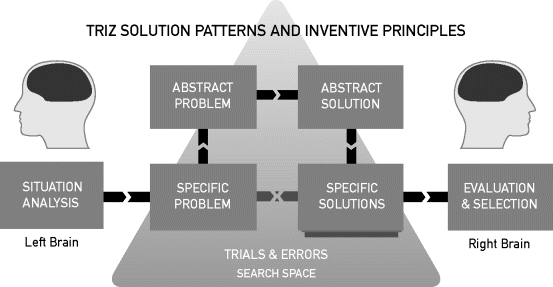
- Place one object inside another.
- Increase the number of objects nested.
- Make one object pass through a cavity of another object.
- Introduce a new process inside of an existing process.
- Increase the number of “nested” processes.
- Make process activities dynamically appear when needed and disappear when not needed.
Principle of Spheroidality
- Instead of linear parts of an object, use curved parts.
- Use rollers, balls, and spirals.
- Use rotary motion.
- Use centrifugal forces.
- If a process is nonlinear, consider increasing the degree of nonlinearity.
- Use circular flow instead of linear flow.
- Use roundabout solutions in a process.
This knowledge-based approach drastically reduces amount of time needed to find a specific solution. One of the best-known TRIZ techniques is called 40 inventive principles. The principles are used through the so-called contradiction matrix, which contains references to specific inventive principles according to over 1,000 types of generic technical contradictions.
2.4.4 Five Levels of Solutions
Not all inventions are equal. Some inventions result in truly new, breakthrough technologies that require relatively a long research and development time and have to pass through all stages of technology development as discussed in Section 2.5.3, “Technology Readiness Levels.” But some inventions are rather simple and do not require extensive research and development to be implemented. For instance, it would be difficult to compare the invention of a laser with the invention of adding an extra thermal insulation layer to a coffee maker.
Figure 2.4.3 shows how TRIZ distinguishes between different levels of solutions. Level 1 includes solutions that do not really require invention: These are standard solutions that can be obtained by optimization. Level 2 requires innovative thinking, but the resulting solutions are still rather simple modifications of existing products and systems. Level 3 is where “real” innovation takes off: A certain system, product, or principle finds a radically new application area. Level 4 includes so-called “pioneering” inventions: A radically new combination “function or principle” is created (usually drawn from scientific studies at level 5). And level 5 is formed by scientific discoveries that can be implemented in new pioneering inventions. Sometimes levels 4 and 5 coincide.
Figure 2.4.3 Levels of technical solutions
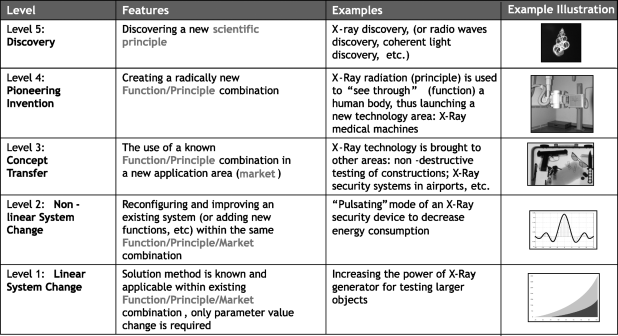
As is clear from this description, the total number of solutions drops with each next level. There are many more level-2 solutions than level-4 ones. Level-4 solutions represent only a fraction of all known technical solutions.
2.4.5 Evolution of Technical Systems
In general, every technical system (product or technology) follows three general phases of evolution before it is replaced by a more effective system based on a new principle: birth, growth, and maturity (Figure 2.4.4).
Figure 2.4.4 Evolution stages of technical systems
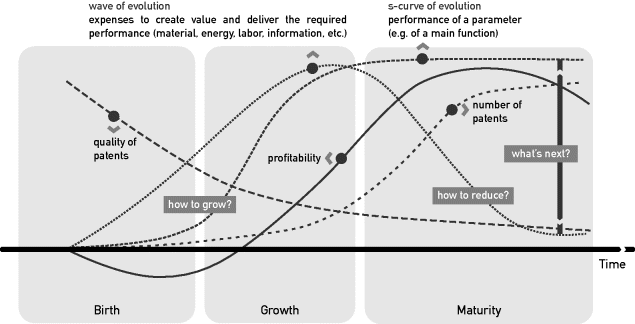
The curves in the figure represent the following:
- The S curve of evolution shows how performance of a main system parameter (of a certain function delivered by a system) changes over time provided a basic principle of function delivery is not changed. When a system is just created, the parameter's performance is usually rather low. However, the function became possible and that matters above all at this stage.
- The wave of evolution curve shows how a typical technical system evolves respectively its physical dimensions, energy consumptions, and costs. At the stages of birth and growth, the system tends to become more massive, energy consuming, and expensive. However, at the stage of maturity, specific values representing these parameters tend to decrease. The first electronic tape recorders that used semiconductors were bulky and costly. Later they were transformed into inexpensive small cassette recorders.
- The quality of patents curve shows that high-level inventions (level-3 and level-4 solutions) are usually made when a system is just created. When the system becomes mature and commercially successful, most of the patents filled protect solutions of level 2 and sometimes 1.
- The profitability curve indicates that during the stages of birth and grows, financial investments are usually made without any profit. Return of investments starts only when a technical system is successfully distributed at the market.
- The number of patents curve indicates an increase in the number of patents filled to reduce competition when a system becomes commercially successful.
Let us take, for instance, digital photography, where one of the main parameters of value is image quality. The first generation of digital cameras produced very low quality. In addition, these first cameras were bulky and costly. However, a new function was created, capturing images digitally, and it was a breakthrough invention. Then the next phase (growth) started: All efforts were put into making digital cameras produce high-quality images. With each innovation, the image quality grew rapidly. After 10 years of further evolution, even small pocket cameras reached the quality of good “old” film cameras. Now this parameter is in the “maturity” stage: We really do not need to invest extra money to increase the quality of images (at least for the mass market), thus the S Curve becomes flat and now camera manufacturers pay attention to improving other parts of a digital camera or reducing the costs of delivering its functions.
What happens when we exhaust the resources of evolution within a given working principle? The same as what happened with film cameras: They were replaced by digital ones. Such transition usually means that we considerably boost the functionality and performance of a system or product by replacing a working principle behind delivering its main function, which prevents a technical system from developing further. The evolution of each technical system can be represented as a timeline of S curves, where each S curve is based on a certain working principle.
2.4.6 Ideality
One of the first discoveries made by Altshuller was that evolution of a vast majority of technical systems follows a so-called trend of ideality growth. In other words, with each successful innovative improvement, technical systems tend to become more “ideal”: They increase their performance, quality, and robustness, whereas the material, energy, labor, and other types of resources needed to manufacture and provide the life cycles of these systems tend to decrease.
The trend of ideality growth plays a very important role in helping us understand how and why systems and products evolve, and define strategies for further improvements of these systems and products.
As seen in Figure 2.4.5, the overall degree of a system's ideality can be increased by increasing the overall value of the system (functionality, performance, etc.), by reducing negative effects that reduce the overall system's value (to improve quality), or by decreasing the resources needed to create and maintain the system's life cycle. Really successful innovations affect all three components in a positive way.
Figure 2.4.5 A system's degree of ideality expressed as a formula

Increasing the degree of ideality does not always means reducing complexity. Just compare a mainframe computer 30 years ago and a modern desktop PC. The price of the desktop PC today cannot be even compared to what organizations had to pay 30 years ago for the mainframe, while the performance and functionality of a modern desktop PC are many times higher (positive effects). It is more reliable, generates less heat and noise, is easier to recycle (negative effects), and costs much less to manufacture and maintain (costs).
2.4.7 Trends of Technical Systems Evolution
During studies of the history of many technical systems, TRIZ researchers discovered that technology evolution is not a random process. Many years of TRIZ studies resulted in extracting a number of general trends governing technology evolution no matter what area technical products belong to. The practical use of these trends is possible through so-called lines of technical systems evolution. Each line of evolution describes patterns of transitions between old and new structures of a system.
One of the evolutionary trends of systems by transitions to more dynamic structures (dynamization) is shown in Table 2.4.1.
Table 2.4.1 TRIZ trend of dynamization applied to the case of mobile phones.
| 1. Monolithic solid object | Traditional mobile phone. | |
| 2. Monolithic object divided into two segments with nonflexible link | Mobile phone with a sliding part that contains a microphone. |  |
| 3. Two segments with a flexible link | Flip-flop phone of two parts. |  |
| 4. Many segments with flexible links | Phone that is made as a wristwatch: Its bracelet is made of segments that contain different parts of the phone. |  |
| 5. Completely flexible, elastic object | A completely flexible phone that can be used as a wrist band. |  |
| 6. A field replaces function of a solid object | A phone without a screen. The function of a screen is delivered by a field-visible light produced by a pico-projector. |  |
Knowing the lines and trends of technology evolution is very important to estimate what evolutionary phases a system has already passed. As a consequence, it is possible to foresee what changes the system might experience in the future and directly generate new ideas.
Currently the TRIZ trends of technical systems evolution are organized in a system (Figure 2.4.6). The trends can be used as an independent tool to reveal evolutionary potential of technical systems and produce ideas for next generations of solutions.
Figure 2.4.6 TRIZ trends of technical systems evolution
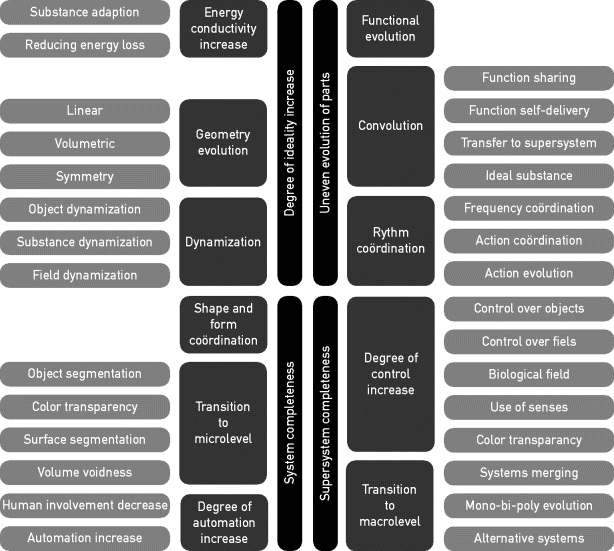
2.4.8 Science for Inventors
New breakthrough products often result from using the latest scientific advances. One of the TRIZ techniques, known as databases of effects, suggests searching for new basic principles by defining what technical function is needed and then finding a scientific principle that can deliver the function.
Studies of patent collections indicated that inventive solutions are often obtained by utilizing physical effects not used previously in a particular area of technology. Knowledge of scientific phenomena often makes it possible to avoid developing complex and unreliable solutions. For instance, instead of a mechanical design including many parts for precise displacement of an object for a short distance, it is possible to apply the effect of thermal expansion to control the displacement.
Finding a physical principle that would be capable of meeting a new requirement is one of the most important tasks in the early phases of design. However, it is nearly impossible to use handbooks on physics or chemistry to search for principles for new products. Descriptions of natural phenomena available in such texts present information on specific properties of the effects from a scientific point of view, and it is not clear how these properties can be used to deliver particular technical functions.
The TRIZ databases of effects bridge a gap between technology and science. In the databases, each general technical function is identified with a group of scientific effects that can deliver the function. The databases consist of three categories of effects: physical, chemical, and geometric. A search for a needed effect or a group of effects is possible through formulation of a technical function (see Table 2.4.2). Examples of technical functions are “move a loose body” or “change density,” “generate heat field,” and “accumulate energy.”
Table 2.4.2 Fragment of the TRIZ database of scientific effects.
| Function | Effects |
| To separate mixtures | Electrical and magnetic separation. Centrifugal forces. Adsorption. Diffusion. Osmosis. Electro-osmosis. Electrophoresis. |
| To stabilize object | Electrical and magnetic fields. Fixation in fluids that change their density or viscosity when subjected to magnetic or electric fields (magnetic and electrorheological liquids). Jet motion. Gyroscopic effect. |
One of the first patents obtained with the use of TRIZ outside of the former ex-USSR was issued to Eastman Kodak. Engineers used the TRIZ databases of effects to develop a new solution for precise linear displacement of a high-end camera's flash. A traditional design includes a motor, a mechanical transmission, and an actuator to convert rotary motion to linear motion. A new patented solution uses piezoelectric effect and involves a piezoelectric linear motor, which is more reliable, cheaper, and easier to control.
Currently, the database of Goldfire Innovator™, a leading software tool that supports TRIZ, contains over 8,000 physical, chemical, and geometrical effects with examples of their applications (Invention Machine, 2011).
2.4.9 Analytical Techniques
It is well known that solving inventive problems is difficult since in most cases they are not formulated correctly. In addition, in many cases it is not clear what problem to solve. In order to deal with ill-defined initial situations, TRIZ introduces a group of tools that help us to perform the needed analysis.
One such tool is function analysis (see Figure 2.4.7), which decomposes systems and products to components and identifies problems in terms of undesired, insufficient, poorly controllable, or harmful functional interactions between both system components and components of a so-called supersystem, which is formed by everything that does not belong to the system but interacts with it. For instance, if a person takes a cup with hot coffee, the cup might be too hot and can burn his or her hand. In this case, a hand of a person is included to a function model and belongs to a supersystem of the system “cup with coffee.”
Figure 2.4.7 A fragment of the function analysis diagram
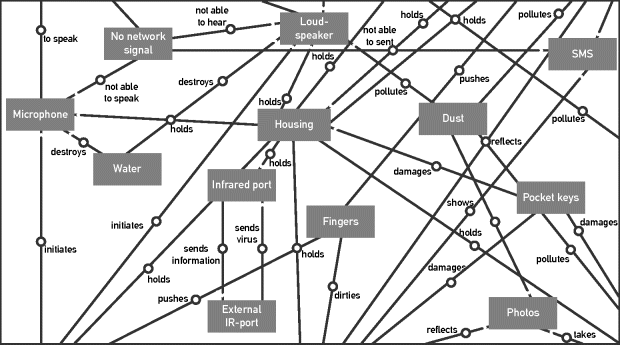
TRIZ-based function analysis helps to identify a range of function-related problems within a system and rank them according to their importance. It can be used not only for finding existing problems but also for identifying resources to increase the degree of ideality of systems and products.
Another tool, recently introduced to TRIZ, is called root conflict analysis (RCA+) (see Figure 2.4.8). Based on a combination of classical RCA and TRIZ philosophy, RCA+ helps to “dissect” a problem formulated as an undesired effect to a tree of causally related underlying negative causes and contradictions. Such a process helps one to understand factors that contribute to the main negative effect and visualize all contradictions that create barriers preventing us from solving a problem in a straightforward way. Later, these contradictions can be directly solved with other TRIZ techniques.
Figure 2.4.8 A fragment of the root conflict analysis (RCA+) diagram

2.4.10 Psychological Inertia and Creativity
Sometimes it is stated that TRIZ reduces creativity. This is not correct. Creativity is one of the crucial factors of successful invention. TRIZ operates at an abstract level, and creativity is very important to translate TRIZ recommendations to real and feasible solution ideas. It is possible to say that TRIZ provides guidelines for the most effective use of creativity and guides our creative search.
Modern innovation demands thinking out of the box and exploiting diverse knowledge. Many innovative challenges, especially the most difficult ones, require a huge number of trials and errors. As pointed by the Industrial Research Institute in Washington, DC, on average, one successful project requires 5,000 raw ideas to be generated. American Management Association reports that 94% of all innovative projects today fail to return investments.
When we start exploring a solution search space, how many directions should we explore to find a right direction? The more difficult a problem is, the more trials we have to make without any guarantee that a desired idea will be found. When Altshuller started to work on TRIZ, his primary goal was to overcome this major disadvantage of chaotic and random idea generation. TRIZ provides navigation within the solution search space, thus directing a problem solver toward an area where a chance to find a desired solution is highest.
Creativity is important to fight psychological inertia, which keeps us locked within existing solutions and ideas and does not let us see things differently. These barriers are difficult to overcome. TRIZ includes a section called creative imagination development that consists of techniques to help with developing our creative skills. Altshuller strongly believed that creative imagination can and must be developed to enable the most effective use of TRIZ. In addition, special psychological “operators” were incorporated to some TRIZ techniques to reduce our mental inertia. For instance, one TRIZ tool, the algorithm of inventive problem solving (ARIZ), introduced a stepwise algorithm of reformulating an initial problem by executing a number of procedures that reduce our psychological inertia and help us to recognize “hidden” resources to solve the problem.
2.4.11 Practical Value of TRIZ
TRIZ is not a magic wand that solves problems all by itself. Creative solutions are always found by people. But TRIZ eliminates a painful process of generating hundreds or even thousands of trials and errors and waiting many years for a new insight.
As reported, today TRIZ and TRIZ software tools are used in about 5,000 companies and government organizations across the globe. In 2006, Samsung Electronics officially stated that within 2004–2006, the use of TRIZ provided the company with total economic benefits of €1.5 billion. Thanks to TRIZ, Boeing Corporation designed a better refueling tanker on the basis of 767 aircraft than similar aircraft of a competitor, and it helped the company to win a contract totaling more than €1 billion. Intel Corp. recently named TRIZ as “Intel's innovation platform of the twenty first century.”
In general, the use of TRIZ provides the following benefits:
- Considerably increases productivity when searching for new ideas and concepts to create new products or to solve existing inventive problems.
- Increases the ratio of useful ideas to useless ideas during the ideas generation process by providing immediate access to hundreds of unique innovative principles and thousands of scientific and technological principles stored in TRIZ knowledge bases.
- Reduces the risk of missing an important solution to a specific problem due to a broad range of generic patterns of inventive solutions offered by TRIZ.
- Uses scientifically based trends of technology evolution to identify evolutionary potential of a technology or product and select the right direction of evolution.
- Leverages the intellectual capital of organizations via increasing a number of patented solutions of high quality.
- Raises the degree of personal creativity by training individuals and groups to approach and solve inventive and innovative problems in a systematic way.
- Structures and organizes the creative phases of the innovation process.
- Supports patents strategies (circumvention, umbrellas, etc.).
- Introduces a common “innovation” language to improve communication.
TRIZ is the most powerful and effective practical methodology of creating new ideas available today. TRIZ does not replace human creativity. Instead, it amplifies it and helps to move it in the right direction. As proven during long-term studies, virtually everyone can invent and solve nontrivial problems with TRIZ. However, modern TRIZ is a complex discipline; therefore, to learn and master skills with it demands time and effort. But thanks to recent advancements in TRIZ education and the development of new software and engineering support tools of systematic innovation, this process is not as difficult as in the past. Recently, TRIZ was included as a supporting tool for Six Sigma to solve problems that cannot be solved with traditional methods. TRIZ conferences and congresses are conducted annually in many countries.
2.4.12 Application of TRIZ
In 2011 Geurds and Van der Molen developed a product concept based on the use of piezo-electric sensors. The concept, called the BandOK system, measures the pressure of car tires while driving and gives feedback to car drivers on the pressure, because well-maintained tire pressure makes it safer to drive and saves fuel, money, and exhaust. During their design process, students applied TRIZ during concept selection and final design of the product, whose use is shown in Figure 2.4.9 and whose technical principles are illustrated in Figure 2.4.10.
Figure 2.4.9 User scenario of the BandOK product by Geurds and Van der Molen (2011)
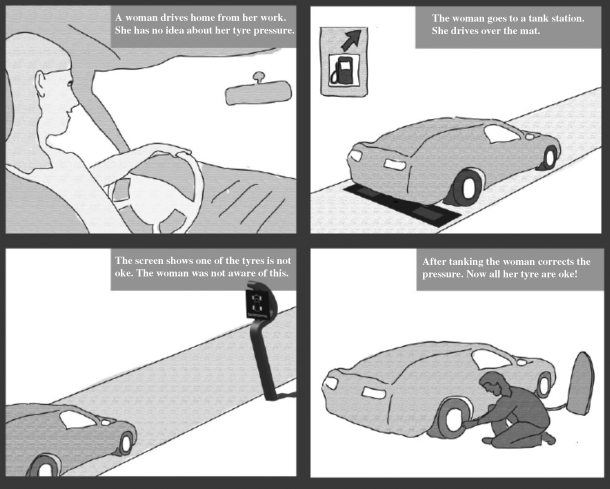
Figure 2.4.10 Scheme of the technical functioning of the BandOK product concept (Geurds and Van der Molen, 2011)
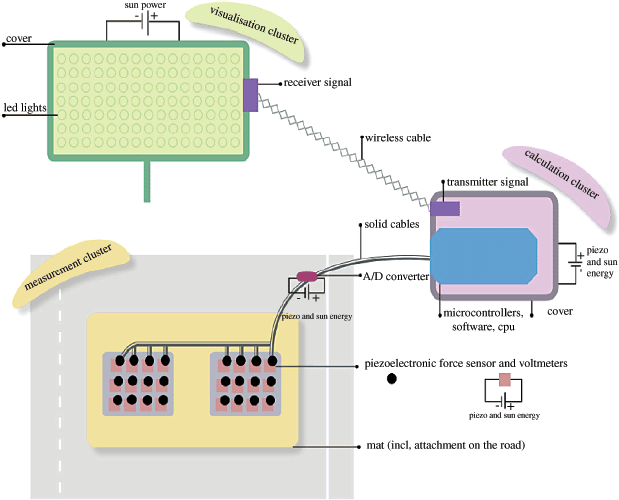
In the embodiment design phase, the TRIZ principles shown in Table 2.4.3 were applied to their product concept with a focus on tire pressure. The ideas that were generated in this way were evaluated and partially applied in their final product concept.
Table 2.4.3 TRIZ principles applied to the BandOK concept.
| TRIZ principle | Ideation BandOK |
| Segmentation | Two measuring units on each side of the road |
| Two measuring units, one for left wheels and one for right wheels | |
| Merge | iPhone app or TomTom device instead of separate display unit |
| Combine with other measuring and information devices (e.g., a check for your lights) | |
| Integrate speeding flash pole | |
| Prior (anti-) action | Weather resistant |
| Vandal proof | |
| Other way around | Make display unit moveable: projection on asphalt, car screen |
| Pump the tire before you see if it is flat | |
| Dynamization | Moveable service station (e.g., ANWB Service Centrum, the Netherlands) |
| Field measuring instead of physical product | |
| Periodical | Only take a picture when a car passes |
| Only give feedback when a car passes | |
| Only measure or be active when a car passes | |
| High speed | Communication between camera, sensors, and display |
| Intermediary | Get feedback later, by e-mail or by logging into website |
| Replacement | Modules, platform-driven development |
| Easy to repair, update | |
| Composite | PV unit integrate in shell or pole |
| Extra light source to take picture in the dark |
